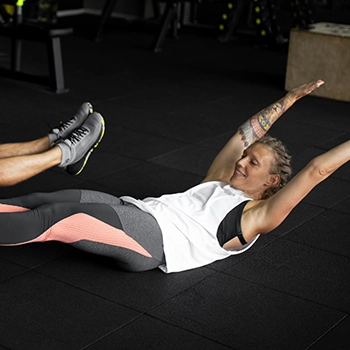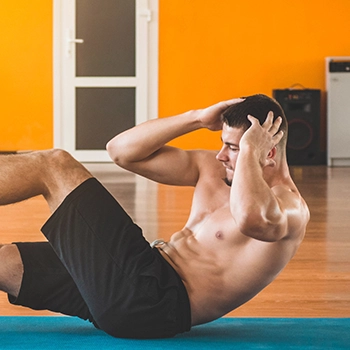Adding a static hold exercise to your core and ab workout days can significantly transform your upper body physique.
And as a certified fitness coach, I have seen many people finally get those six-pack abs with these highly targeted exercises.
But you have to make sure that you avoid simple errors that could otherwise cause strain and injuries.
So, our team decided to do some testing over a few weeks to see which static hold abs exercises work the best and what you need to do to get the best results.
Quick Summary
- Static hold abs exercises such as side planks, hollow holds, and L-hang pull-ups are key for enhancing core strength by maintaining a fixed position for a set duration.
- It's crucial to maintain correct form in static hold exercises to avoid injuries, especially in the spine and legs.
- Improper form in abdominal exercises often leads to increased pressure on joints, disks, and nerves, a significant factor in the rise of workout-related injuries, as reported by WebMD.
- In my opinion, integrating static hold exercises into your routine is an effective way to build a resilient and powerful core, essential for overall fitness and injury prevention.
How To Do Static Holds For Best Results

In my years as a fitness coach, I've found that mastering the form in static hold exercises is pivotal for best results.
Here are instructions for three static hold workouts that will help you do them with proper form.
1. Side Plank (Easy)
The side plank is probably the simplest way to add a static hold to your core workouts:
- Lay down on your side and raise your upper body up and lean on your elbow.
- Keep your legs straight and lift your hips up until your spine is in a neutral position and your body is in a straight line.
- Your shoulder blades will push together, and you should feel good strain in your core.
- Hold the position for 60 seconds or longer, and don’t let your hips sag.
2. Hollow Hold (Intermediate)

This takes your abs exercises to a tougher level:
- Lay down on your back with your legs straight and arms stretched over your head.
- Pull your belly button in and lift your arms and shoulders as well as your feet off the ground.
- Keep your core tight and hold the position for 30 seconds, and even try to raise your limbs a bit higher.
3. L-Hang Pull-Up (Advanced)
This is a more advanced workout that will require a pull-up bar:
- Hang from the bar with your palms facing away from your body.
- Raise your lower body and get your legs straight and parallel to the ground.
- Do as many pull-ups as you can and feel the burn developing in muscle groups of your back, shoulders, arms, and core.
It’s also a great exercise to develop more grip strength, especially when you try to hang for longer [1].
To make this another bit tougher, try doing a toes-to-bar movement or a chin-up every ten seconds.
Avoid Mistakes

Maintaining correct alignment—particularly keeping your spine and legs straight—is crucial during long-duration isometric exercises.
Improper form can lead to undue pressure on joints, disks, and nerves. And that is a very common cause of the significantly increasing number of ab workout injuries, according to the WebMD [2].
Whether you’re doing a basic glute bridge or an advanced hanging toes-to-bar exercise, always try to prevent injury rather than pushing yourself too far.
Through years of coaching, I've seen that proper alignment, especially in the spine and legs, is key to preventing injuries in isometric exercises.
Nutrition plays a pivotal role in maximizing the effectiveness of static hold abs exercises. A diet that supports core strength and endurance, possibly supplemented with specific nutrients, can significantly enhance the benefits of these exercises.
“When you begin an exercise routine or start a new workout program, start slowly. Then gradually build up the intensity, duration, and frequency.”
- Tyler Wheeler, MD
What Are The Benefits?
In my coaching career, I've observed that static holds rapidly enhance core strength and muscle tone.
By regularly adding these static workouts, you can get a full six-pack from your rib cage down to your pelvis.
And by targeting each muscle groups around your core, you’ll also be building a rock-solid foundation for heavy lifts.
Beyond physical benefits, static hold abs exercises also contribute to mental health and mindset enhancement. Regular practice can aid in stress reduction and help in developing a focused and meditative state, underscoring the importance of a holistic approach to fitness that encompasses both mental and physical well-being.
FAQs
Can Static Holds Build Abs?
Yes, static holds can build abs. Because you extend the amount of time your muscle fibers are under full tension, it can help add more strain and build up more muscular strength.
How Long Should You Static Hold?
You should static hold for as long as you can keep your core engaged with good form. As soon as you feel your body sagging or your grip losing strength, it’s time to take a break. Keep track of your time to see your progress over the weeks ahead.
Make Static Holds Part Of Your Routine
For your next exercise session focusing on your core, aim to introduce a couple of the static routines above.
And to ensure you build and maintain muscular strength and recover faster from the strain, make sure you invest in a top-quality protein supplement.
Here are some that we thoroughly tested:
These provide critical nutrients to help your muscle tissue fully repair and rebuild, making your recovery time faster and easier.
References:
- https://www.physio-pedia.com/Grip_Strength
- https://www.webmd.com/fitness-exercise/workout-injuries-prevention-and-treatment
About The Author
You May Also Like






